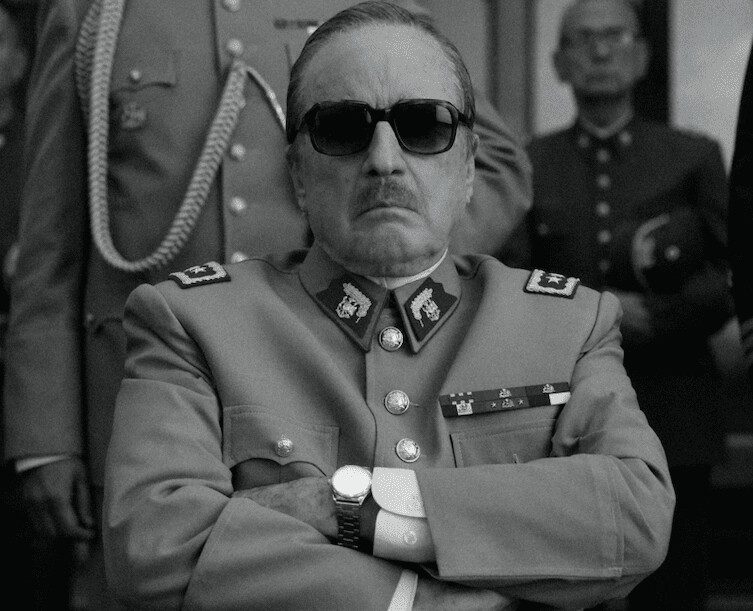
You might expect a movie portraying Augusto Pinochet (Jaime Vadell) as a vampire to follow the same narrative beats as a biopic, just with a vampiric twist—not unlike Abraham Lincoln: Vampire Hunter. While co-writer/director Pablo Larrain’s El Conde shows a few moments involving Pinochet’s real history, it mostly tells a new, distinct story, one that takes place after Pinochet, at least according to our history, died.
In El Conde, the mythic nature of the vampire and the raw, true evil of Pinochet work in a delicate balance between fantasy and reality. Larrain and cinematographer Edward Lachman’s black and white images, which sometimes harken back to Nosferatu, highlight the grotesque blood and gore created by a vampire and war criminal. Though on the other side of good and evil, it might almost be compared to C.S. Lewis’s creation of Aslan, not as an explicit allegory, per se, but, as Lewis called, a “supposal.” What if Pinochet were a vampire? What if he lived before we thought he had? What if he were still alive? How could we use that myth, this supposal, to compliment historical truth?
El Conde sets Pinochet’s foundation for human evil well before his historical birth. He’s so old he saw the death of Marie Antoinette (even keeping her head as a well-preserved souvenir centuries later). At this time, he’s unaware that he’s a vampire, and the film shows his bloodlust exists beyond the vampire’s need to survive. In a brutal scene where a Priest and some Nuns (who know he’s a vampire) attempt to stake his heart, Pinochet responds with violence that evolves. First, he kicks one of his captors in self-defense. Then, he attacks a few others, in acts that could conceivably be perceived as self defense. Then, he stands over one last helpless, sobbing captor and bashes their face in. Repeatedly. With a hammer. Even after they’re dead. The scene ends without him drinking a drop of blood.
The real Pinochet neither had nor needed centuries to cultivate a soul to be capable of his vast crimes, yet the film uses his quasi-immortal long life to complement this real life evil. During the intervening centuries, Pinochet’s life is presented as a curious traveler, taking part in any war that allows him to slaughter rebels. When he becomes the Pinochet of history, it’s shown as an opportunity he decided to embrace with curiosity. Even after living centuries, seeing an assortment of war and bloodshed, El Conde’s Pinochet embraces his place in history that we know, as one would embrace a promotion.
Following a brief montage of this time in history, the film jumps to after his historical death, where he hides with his wife (Gloria Munchmeyer) and servant (Alfredo Castro) in a decaying mansion that can only be reached by boat. Surviving on stocked hearts and other organs, he’s simply living to live. Here, the delicate balance of fantasy and reality takes further hold, by domesticating the vampire drama. The voluntarily immortal Pinochet has decided to die, and summons his offspring to sort out their inheritance. Amongst their offspring, however, is a mysterious accountant (Paula Luchsinger). She’s here to uncover Pinochet’s secretive funds, to see which should go to which child, but she clearly has another purpose, secretly working in conjunction with one of his children.
This is one of the most compelling elements of El Conde: no one is to be trusted because everyone is rotten. Someone conspiring against a vampiric dictator doesn’t make them a saint, it just means they’re trying to get rich or immortal through different means. You might be sad if your favorite character dies horribly, but you’ll get over it when you realize there’s no reason to prefer that rotten soul over the others. Morality can’t win out in a film where no one is moral. El Conde even takes this to an interesting level with Pinochet himself, by giving him a taste of redemption, a sense that he actually wants to end his life and might express regret over his past. All this is, of course, nonsense that goes nowhere.
If the film has a failing, it’s that it doesn’t quite stick the landing. There’s a twist within the film’s last half hour which reveals the historical identity of the previously anonymous narrator. The twist is clever on a conceptual level and might inspire a laugh when you get it, but it’s difficult to say whether the film does enough with this twist or the satirical point it’s trying to make. It’s like an Easter Egg in something like the Marvel franchise or Super Mario Bros, only it’s a politically satirical easter egg. Yeah, you get it, but what’s it worth?
Yet the rest of the film is so strong, so grim, and so beautiful, that I would be remiss to dismiss it because of a somewhat bumpy landing. There’s a scene when a newly turned vampire takes flight for the first time, and it’s a marvelous use of wonder to express the pleasure of sin. The character who turned might have been the closest thing to a redemptive human being the film had, and they gave it up for the possibility of immortality like that. This flight, which is choreographed and scored as though it could be a musical, uses the beautiful freedom of interpretive dance to underscore how horribly desirable the gifts of a vampiric war criminal may be.
The serviceable-but-shrug-worthy ending may leave an immediate sour aftertaste when finishing El Conde, but impactful images, clever concepts, and moments like that first flight will stick with you in the days that follow.

